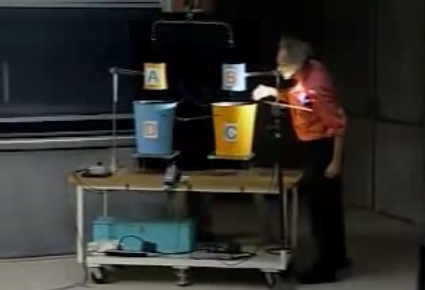 Presumably, this experiment involves the phenomenon of electrostatic discharge. Static electricity accumulates from the friction of the air with water on both sides, is stored into the two circular cans and the collection buckets.
Presumably, this experiment involves the phenomenon of electrostatic discharge. Static electricity accumulates from the friction of the air with water on both sides, is stored into the two circular cans and the collection buckets.
The charge disturbs normal water flow for a few seconds, and after the voltage difference between the two is high enough to permeate air, the spark occurs.
One could use this to light up a fire or charge a small battery where there’s no other source of electricity present. Of course, patience is needed – the energy developed by this is small, but I guess pouring in higher volumes of water can yield more useful results.
Of all the science experiments I’ve ever seen, this has caught my eye and is by far the most simple and interesting. It uses a source of water, two cans and two recipients. Sounds simple enough? Professor Walter Lewin from MIT let us see how he does it:
The Pedal-A-Watt generator allows you to pedal and create electricity


This is really interesting. we people have only most of times read this theoretical than having practicals and yet we brag that we know physics. infact if such were directly taught in advanced level mostly in Uganda, then we would be some where with the physics taught here. so personally I would love to have more of your practical experiments so as to be knowledgeable. as far as physics is concerned. thanks